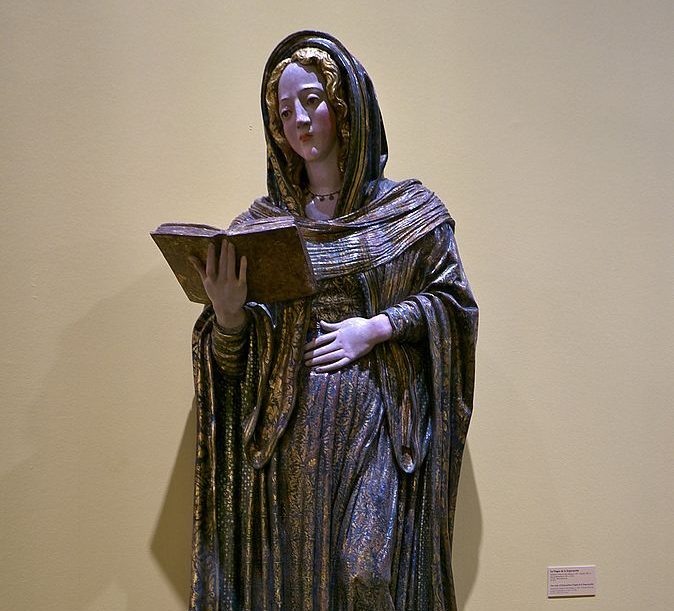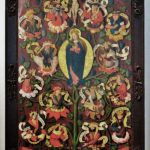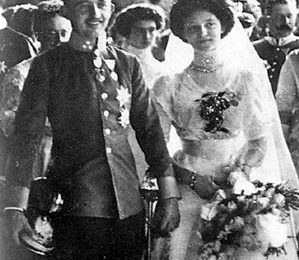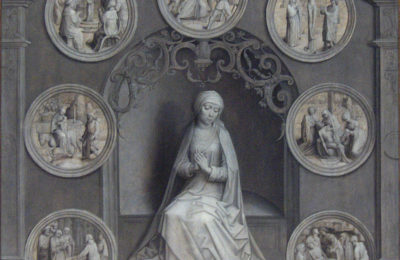Today, while it is a Friday ember day in Advent, the Roman Catholic Church commemorates the Expectation of the Blessed Virgin Mary. The history of this commemoration is long and rich. The following post contains a bit of that history; and subsequently points to a prolife film. Let us start with the history of the Expectation:
Today is one of the most inspiring days preceding Christmas! It is the feast of “Our Lady of Expectation,” mostly unknown to many in these modern times, but still kept alive in many countries like Spain, Portugal, Italy and Poland as well as in a few religious orders. In older editions of missals, this feast is still listed as a votive Mass.
The feast is celebrated on the 18th of December, a week before Christmas Day. Our Blessed Lady, well advanced in pregnancy, is portrayed in the highest dignity of her Divine Motherhood. Dressed in royal apparel as daughter of David the King, she awaits with joy the arrival of her divine Son, Jesus, the Prince of Peace. Her whole posture suggests how she remains wholly consumed in contemplation of her Son under her heart. Her immaculate womb has become a living portable sanctuary of divinity. There are special prayers and novenas to “Our Lady of Expectation” available for women who cannot conceive or bear a child.
The votive Mass of “Our Lady of Expectation” is theologically enlightening and spiritually enriching for the time of Advent and Christmas. With the entrance antiphon, the Church prays with the prophet for the coming of the Just One from heaven that the earth may be ready to welcome the Savior: “Send victory like a dew, you heavens, and let the clouds rain down the just. Let the earth open for salvation to spring up” (Is 45:8). In the opening prayer, the Church offers the prayer to God through Mary’s intercession: “O God who wished that your Word would take the flesh from the womb of the Virgin as announced by the Angel and whom we confess to be the true Mother of God, may we be helped by her intercession.”
This wonderful feast also reminds us that it has been almost nine months since the Annunciation/Incarnation (March 25) and that Jesus developed in Mary’s womb just like we did in our mother’s womb. Think of all the millions of babies who never make it through the nine months because their mothers have aborted them. May God, through the intercession of the Expectant Mother Mary, take their souls into His Kingdom. (source)
Dom Prosper Gueranger (b. 1805- d. 1875) speaks of this day in the following:
This Feast, which is now kept not only throughout the whole of Spain but in almost all the Churches of the Catholic world, owes its origin to the Bishops of the tenth Council of Toledo in 656. These Prelates having thought that there was an incongruity in the ancient practice of celebrating the feast of the Annunciation on the twenty-fifth of March, inasmuch as this joyful solemnity frequently occurs at the time when the Church is intent upon the Passion of our Lord, and is sometimes obliged to be transferred into Easter Time, with which it is out of harmony for another reason – they decreed that, henceforth, in the Church of Spain there should be kept, eight days before Christmas, a solemn Feast with an Octave, in honour of the Annunciation, and as a preparation for the great solemnity of our Lord’s Nativity. In course of time, however, the Church of Spain saw the necessity of returning to the practice of the Church of Rome, and of those of the whole world, which solemnise the twenty-fifth of March as the day of our Lady’s Annunciation and the Incarnation of the Son of God. But such had been, for ages, the devotion of the people for the Feast of the 18th of December, that it was considered requisite to maintain some vestige of it. They discontinued, therefore, to celebrate the Annunciation on this day; but the faithful were requested to consider, with devotion, what must have been the sentiments of the Holy Mother of God during the days immediately preceding her giving him birth. A new Feast was instituted, under the name of the Expectation of the Blessed Virgins Delivery.
This Feast, which sometimes goes under the name of Our Lady of O, or the Feast of O, on account of the Great Antiphons which are sung during these days, and in a special manner, of that which begins Virgo Virginum – is kept with great devotion in Spain. A High Mass is sung, at a very early hour, each morning during the Octave, at which all who are with child, whether rich or poor, consider it a duty to assist, that they may thus honour our Lady’s Maternity, and beg her blessing upon themselves. It is not to be wondered at that the Holy See has approved of this pious practice being introduced into almost every other country. We find that the Church of Milan, long before Rome conceded this feast to the various dioceses of Christendom, celebrated the Office of our Lady’s Annunciation on the sixth and last Sunday of Advent, and called the whole week following the Hebdomada de Exceptato (for thus the popular expression had corrupted the word Expectato). But these details belong strictly to the archaeology of Liturgy, and enter not into the plan of our present work; let us, then, return to the Feast of our Lady’s Expectation, which the Church has established and sanctioned as a new means of exciting the attention of the faithful during these last days of Advent.
Most just indeed it is, Holy Mother of God, that we should unite in that ardent desire you hadst to see Him, who had been concealed for nine months in your chaste womb; to know the features of this Son of the heavenly Father, who is also yours; to come to that blissful hour of his Birth, which will give Glory to God in the highest, and, on earth, Peace to men of good-will. Yes, dear Mother, the time is fast approaching, though not fast enough to satisfy your desires and ours. Make us redouble our attention to the great mystery; complete our preparation by your powerful prayers for us, that when the solemn hour is come, our Jesus may find no obstacle to his entering into our hearts.
The Great Antiphon to Our Lady
O Virgin of virgins, how shall this be, for never was there one like you, nor will there ever be. You daughters of Jerusalem, why look you wondering at me? What he behold is a divine mystery.
(source: The Liturgical Year: Advent, by the Very Reverend Dom Prosper Gueranger, Abbot of Solesmes, translated from the French by the Revered Dom Laurence Shepherd, Monk of the English-Benedictine Congregation, 2nd edition; published in Dublin Ireland by James Duffy, 15 Wellington-Quay, 1870)
~Further reading for today’s O Antiphon, here. Note: the linked website posts daily updates with liturgical information; it is quite helpful.
Yesterday, I read an interesting interview of John Zmirak with Jason Jones, the creator of a short (fifteen minute) free pro-life film. The article was titled The Most Beautiful Prolife Film in History? and was published on The Stream. You may read the article here. To view the film, which is titled, Crescendo, the link is here. Note: the film is not for children.
This little movie is quite moving; the end is dazzling. I think this topic ties into today’s feast, the Expectation of the Blessed Virgin Mary: let us hope that life in the womb may be protected and nurtured all over the world. Hail life!
May you have a good day.
~SCF
~Image: Our Lady of Expectation, 16th century, source with details. Image edited to fit thumbnail.






